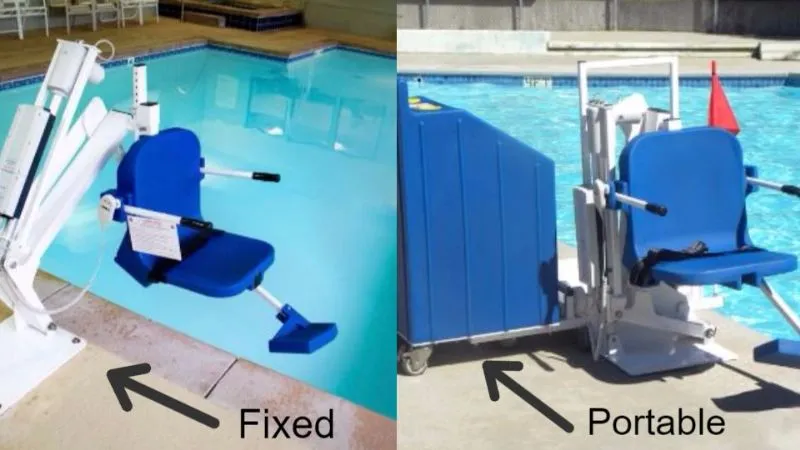~1.jpg&newwidth=80) Written by Jeanine Clancy, MEd, BSN, RN
Written by Jeanine Clancy, MEd, BSN, RN
Time spent in a pool or spa can be therapeutic as well as relaxing, and a disability doesn’t have to keep anyone from enjoying the benefits of time in the water. Aquatics enables a wide range of low-impact exercises, and being in the water stimulates metabolic and neuromuscular systems beneficial for mobility and overall wellbeing. With the effect of gravity on the body minimized, there is less stress on muscles and joints, facilitating stretching and strengthening exercises that are simply more comfortable and effective when done in water. Pool lifts assist people with disabilities or limited mobility in safely entering and exiting a pool or spa, allowing access to all the benefits of aquatic activities.
A handicap pool lift is a mechanized seat with a passive restraint that uses a lift-arm to safely raise and lower a person with limited mobility into and out of a pool or spa. The seat can be made of mesh or plastic. They can be customized with headrests, footrests, armrests, and back support and can be powered by a hand crank, water-powered hydraulics, or batteries. The lift can be operated manually or with a handheld remote.

A fixed pool or spa lift works best for people who want water access at any time and don’t want to be bothered with moving and setting up the lift every time it’s used. The main advantage of a permanent pool lift is the convenience of not having to expend the effort required to remove and reinsert a lift. This kind of lift supports a user's maximum level of independence since assistance isn’t required to get the lift in place when it’s time to get into the water. These models are often less expensive than portable lifts.
For people who either don’t need their pool lift available at a moment’s notice or don’t want their pool’s aesthetics permanently altered, a portable lift is a preferable choice. In addition, portable pool lifts can be stored, and better protected from the elements when not in use, then moved into position poolside on an as-needed basis.
Fixed pool lifts have a post that sits in a sleeve in a concrete pool deck. Portable lifts are on wheels and usually weigh less than 100 pounds.
Since an outdoor inground pool doesn’t present any clearance issues, there are more options available for pool lifts to fit that type of pool.
Suppose there is a wall or other obstacle the user needs to be transported over, as is often the case with an above-ground or partially-above-ground pool or spa. In that case, the lift will need to be among those that can raise the user high enough to clear any obstacles safely.
An indoor or covered pool or spa will have a ceiling height that needs to be considered, which could also limit your purchase options.
.jpg)
Manual pool lifts require a hand crank or hydraulic cylinder to turn a gear and require assistance from another person to use. They are usually permanently installed. They can’t be independently operated. The most affordable option, requiring the least amount of maintenance, is most often used in residential setting.
Water-powered hydraulic lifts are connected to a water supply through a pipe or hose and are generally permanently installed. They are more expensive than manual lifts and less expensive than battery-operated models. Hydro-powered pool lifts utilize a valve system to fill a cylinder positioned against the pool wall with water to create pressure and raise the lift, then drain the cylinder to release the pressure when it’s time to lower the lift. Lifting capacity is dictated by the water pressure, which can vary depending on the local water supply. In addition, the seals need to be maintained to ensure the system doesn’t leak. These lifts are ADA compliant when used with a compatible pool that allows them to be operated independently.
Powered pool lifts can be operated with a handheld control by the user, making them ADA compliant and therefore popular in commercial applications. They implement a battery-powered electronic actuator to drive the lifting system and feature a high lifting capacity. Powered models are the most expensive kind of pool lift. They don’t require much maintenance, but batteries do need to be replaced from time to time. However, powered pool lifts are the most dependable, delivering the most features while being the easiest type of lift to operate.
Bariatric pool lifts generally serve users in the 350-500 weight range, although there are models available that can support up to 1,000 pounds.
For home use, you can choose a model that will best serve who will be using it in your pool.
To be ADA-compliant, a pool lift must support a minimum weight of 300 pounds. However, for commercial applications, you should consider a higher weight capacity to ensure pool access is available to as wide a range of people as possible.
Using a pool lift allows someone with limited mobility to safely enter and exit a pool or spa. Different levels of ability and mobility can affect the features you need in a pool lift. A seat belt is always a good idea if there is any chance that a user will slip out of the chair and into the water or onto the pool deck while seated in the lift. Legrests, armrests, headrests, and lumbar support are available features for people who cannot independently maintain their position while seated.
Aquacreek Products is a popular and trusted brand for its full line of manual, water-powered, and battery-powered pool and spa lifts. Many of their pool lifts offer 360 degrees of rotation, and they come in portable or permanently installed versions appropriate for in-ground, recessed, or above-ground pools and spas.
Shop Aquacreek’s full line of pool lifts. Their diverse selection is sure to have a model with features that will be a great fit for your residential or commercial pool or spa.
Spectrum Products produces ADA-compliant lifts for commercial swimming pools and spas. They produce manual and water-powered lifts, but they are best known for their high-capacity battery-powered lifts. In addition, their product line features several bariatric models with public pool applications in mind to serve a wide range of users.
View the full line of commercial Spectrum Products pool lifts for more information on these full-featured, ADA-compliant pools and spa lifts.
Global Lift Corp. produces portable, stationary, battery-powered, manual pool and spa lifts. Their ADA-compliant lifts are suitable for use in residential or commercial pools. Many of their lifts are compatible with existing anchors, so they are a popular choice when it’s time to replace or upgrade a pool or spa lift. In addition, they have lifts that feature an anti-pinch linkage system, and some stationary models can be converted any time to a portable lift with a conversion kit.
Check out the line of Global Lift Corp pool lifts available for public and residential pools.
Yes, after purchasing a pool lift, you need to hire a professional installer, even for a portable lift. Attempting to install a pool or spa lift can damage the lift or the pool and invalidate a manufacturer’s warranty. Pool lifts are not a DIY project.
ADA compliance is required for lifts installed for public use, ensuring a wide range of users can enjoy independent access to a pool or spa. However, if you are purchasing a lift for residential use, you can determine the features you need, and ADA compliance is not required.
No, installing a pool lift does not require a permit.
If your above-ground pool does not have a deck around it, then clearance is the biggest consideration, as the lift needs to get the user up and over the pool wall. The Global Rotational Series 450A and the Aqua Creek Power EZ are examples of high-clearance lifts designed for above-ground pools. If you choose a stationary model for an above-ground pool with a wood or concrete deck, ensure an anchor kit is available for secure installation.
Aquatic therapy can be especially beneficial for seniors. Buoyancy can relieve sore joints and minimize the risk of bedsores for seniors who spend a lot of time in bed or a wheelchair. A battery or hydro-powered model with remote control is easiest to operate, and a lift with a mesh sling makes wheelchair transfers easier than a rigid seat lift with armrests. The Power EZ Lift has these features. It is a great option for seniors with its 400-pound weight capacity, 360-degree manual rotation for full accessibility, and multiple anchor systems to fit just about any application.
The healing properties of water therapy can be especially impactful for people with disabilities, joint pain, and limited mobility. The anti-gravity buoyancy decreases stress on joints and muscles and makes underwater movement easier than on land. In addition, pool and spa lifts provide safe access to beneficial aquatic activities that contribute to optimal physical and mental health.
Choosing the best lift for your pool or spa has many features and benefits. Whether or not the lift needs to be ADA compliant, how the lift is raised and lowered, and the weight capacity all figure into a purchasing decision. Budget and available options might also influence your choice. Our catalog of pool lifts features high-quality products.
Visit Caregiver University for more information, including product reviews and buying guides created to help you make the best choice for your pool lift needs.

Jeanine has been a nurse for twenty-seven years with an extensive background in perioperative services, school/community health, quality/education, and leadership/administrative roles. Jeanine creates high-quality health content and is a mom (to 4 fabulous kids), dog mom, and avid hiker.